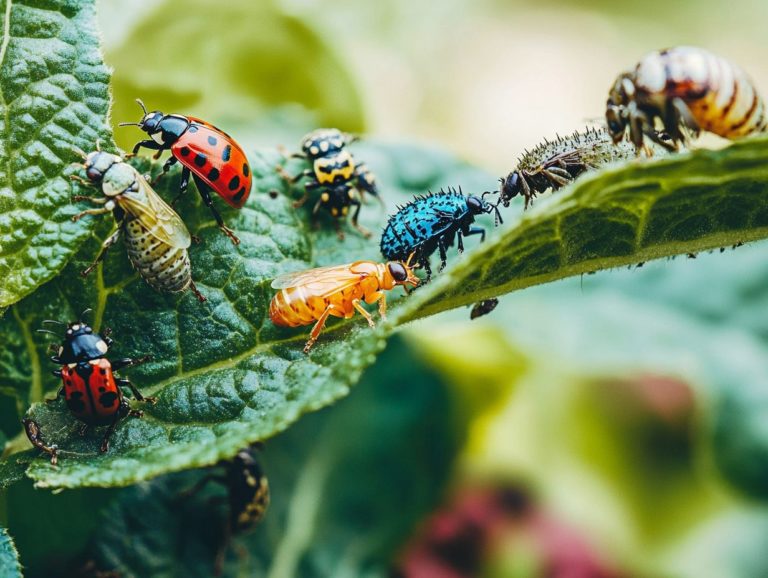How to Monitor Pests with Sticky Traps
Effective pest management starts with careful monitoring, and sticky traps serve as a formidable ally in this endeavor.
This article delves into the importance of monitoring pests, the various types of sticky traps available, and how to set them up for optimal effectiveness. You ll learn how to interpret the results to make informed decisions against any infestations.
We will also discuss alternative monitoring methods to provide you with a complete view of pest control strategies.
Dive into these insights and boost your pest management skills today!
Contents
- Key Takeaways:
- The Importance of Monitoring Pests
- Types of Sticky Traps
- How to Use Sticky Traps
- Interpreting Sticky Trap Results
- Maximizing Effectiveness of Sticky Traps
- Alternative Pest Monitoring Methods
- Frequently Asked Questions
- What is the purpose of using sticky traps to monitor pests?
- How do sticky traps and monitoring traps work?
- How should I place sticky traps and light traps for optimal monitoring?
- What types of pests can be monitored with sticky traps?
- How often should these traps be checked?
- Are sticky traps safe around children and pets?
Key Takeaways:

- Consistent pest monitoring is crucial for effective pest control.
- There are various types of sticky traps available, each with their own benefits and uses.
- Proper placement and maintenance are key to maximizing the effectiveness of sticky traps.
The Importance of Monitoring Pests
Monitoring pests is essential for sustainable agriculture and effective pest management. This helps you spot pest populations and implement timely interventions, minimizing economic damage.
By employing a range of monitoring tools like sticky traps, pheromone traps, and light traps, you can gain valuable insights into insect behavior. This not only helps you assess the effectiveness of your Integrated Pest Management (IPM) strategies, which combine different methods to control pests effectively, but also safeguards your crops from significant pest damage, ultimately enhancing your yield and profitability.
Why Monitoring is Essential for Pest Control
Effective pest control hinges on precise monitoring, allowing you to grasp pest populations and their potential impact on your crops.
By employing various monitoring techniques, such as sticky traps, you gain vital insights into pest activity and population dynamics. These traps do more than just capture insects; they unveil patterns that guide your pest control decisions.
Research indicates that fields with consistent monitoring experience a remarkable 30% reduction in pest-related damage, whereas unmonitored areas can face losses exceeding $20,000 per season due to rampant infestations.
When integrated into a comprehensive pest management strategy, effective monitoring becomes a cornerstone of your approach, ensuring that your preventive measures are not merely reactive but truly proactive. This ultimately safeguards both your crop yields and economic viability.
Types of Sticky Traps
Sticky traps serve as highly effective tools in pest monitoring, prized for their simplicity and efficiency in capturing adult insects.
You’ll find variations such as yellow sticky traps and blue traps, each meticulously designed to attract specific pest species, tailored to their unique behaviors. This targeted approach enhances your pest control strategy, ensuring optimal results in maintaining a pest-free environment.
How to Use Sticky Traps

To utilize sticky traps effectively, you need to grasp the nuances of pest behavior and adopt a systematic approach to setting them up. This ensures optimal catch rates and allows for accurate monitoring of pest populations.
With the right strategy, you’ll enhance your pest management efforts significantly.
Start using sticky traps now for a pest-free harvest!
Step-by-Step Guide for Setting Up Traps
Setting up sticky traps requires understanding how pests behave to ensure effective monitoring while minimizing the economic impact of infestations.
Choosing the right locations for these traps is crucial; placing them strategically near entry points like windows and doors or along common pathways can significantly boost their effectiveness. Don t overlook the height at which you mount these traps, as many pests have preferred vertical zones. Consider the role of light certain pests are drawn to illuminated areas, so proper exposure is key.
When positioning your traps, aim for a spacing of about 10 to 15 feet between them to optimize coverage. By integrating sticky traps with other monitoring methods, such as pheromone traps (traps that use scents to attract specific pests) or visual inspections, you can gain a more comprehensive understanding of the pest population, ultimately enhancing your overall pest management strategies.
Interpreting Sticky Trap Results
Interpreting the results from sticky traps is essential for you to grasp pest populations and make informed pest management decisions.
This process demands a careful analysis of trap catch data, allowing you to draw meaningful insights that can guide your strategies effectively.
What to Look for and How to Analyze Data
When analyzing sticky trap results, you must identify both the type and number of pests captured, as this data directly influences your pest control strategies and economic outcomes.
By closely examining trap catch numbers and accurately identifying species, you can make informed decisions about when and whether to apply pesticides (substances used to kill or control pests). For example, if you detect a significant population of a particular pest, it could indicate the need for more intensive monitoring or immediate action. Taking action now lets you target treatments perfectly, saving you money and boosting effectiveness!
Understanding pest dynamics not only informs your current strategies but also enhances long-term economic sustainability in agricultural practices, minimizing potential financial losses from pest damage.
Maximizing Effectiveness of Sticky Traps
To truly maximize the effectiveness of sticky traps, you must focus on their strategic placement and commit to regular maintenance. This approach ensures optimal capture rates and provides accurate monitoring of pest activity.
Tips for Placement and Maintenance

Proper placement and regular maintenance of sticky traps are essential for effective pest detection and monitoring, ensuring that these traps remain functional and deliver reliable data.
To maximize their efficiency, you should strategically position the traps in areas where pests are most likely to travel think along walls, entry points, or near food sources. Checking the traps frequently, ideally once a week, allows you to replace them in a timely manner, especially if they’ve captured a significant number of pests or have collected dust and debris that could hinder their performance.
Consider environmental factors like humidity, temperature, and light exposure, as these can also affect trap efficacy. By taking these elements into account when placing and maintaining your traps, you enhance their effectiveness.
Combining sticky traps with other monitoring tools, such as bait stations or visual inspections, creates a more comprehensive pest management strategy, boosting your overall detection and control efforts.
Start monitoring your pest activity today for a healthier home!
Alternative Pest Monitoring Methods
While sticky traps serve as a reliable means for monitoring pests, exploring alternative methods such as pheromone traps, light traps, and plastic pitfall traps can offer you deeper insights into pest populations and their behaviors.
Other Options for Monitoring Pests
Sticky traps are a great start for monitoring pests. You can also consider pheromone traps and light traps, which have unique benefits.
Choosing the best method depends on the type of pest and the environment. Pheromone traps work wonders for insects like moths and beetles, while light traps attract night-active pests.
Integrating these techniques, along with plastic pitfall traps, forms an effective pest control plan. This helps in accurately assessing pest populations and applying timely interventions.
Frequently Asked Questions
What is the purpose of using sticky traps to monitor pests?
Sticky traps help identify the type and extent of a pest problem in an area.
How do sticky traps and monitoring traps work?

Sticky traps, such as yellow and blue traps, use adhesive surfaces to catch pests, making it easy to monitor and identify pest populations.
How should I place sticky traps and light traps for optimal monitoring?
Place sticky traps near pest travel areas, like along walls or near entry points. These should also be part of an Integrated Pest Management (IPM) plan.
What types of pests can be monitored with sticky traps?
Sticky traps can catch various pests, including whiteflies, thrips, Drosophila suzukii, marmorated stink bugs, and even small animals like lizards.
How often should these traps be checked?
Check sticky traps at least once a week. If you suspect an infestation, increase the frequency to minimize damage.
Are sticky traps safe around children and pets?
Place sticky traps where children and pets can’t reach them. Regular checks will help prevent accidental contact, especially with enhancements like kairomones.






